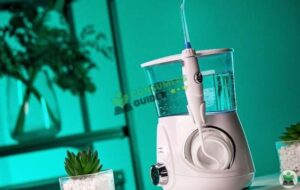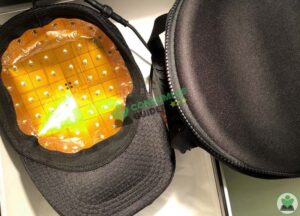There is a time of the year where you have to say goodbye to your above ground pool in order to meet it in the next season. (The Winter)
You don’t want to keep your pool when the temperature drops to damage the pool equipment and for that you need to winterize it even if your are using a pool heater to keep the water warm.
Winterizing your above ground pool (if done properly though) prevents the pool from getting ice damage and a lot of people think it is a complicated process. Actually it is not if you know how to do it.
That’s why we are here to discuss how to winterize an above ground pool easily. Stick to us to get enlightened with the whole process.
Before that, if you are new here, then let us tell you about the basic information about winterizing a pool so you can have a better idea about it.
What Does Winterizing a Pool mean?
For those who don’t know, winterizing the pool means to prevent the pool from getting damaged due to ice.
In the winter season, the pool liners can tear up because the surface freeze up and when ice expands, it damages the pool and its equipment.
Winterizing the pool means you are not going to use your pool for months so you remove the pool equipment, clean it and close it until the next season comes.
Winterizing the Pool Vs Closing the Pool; What’s the difference?
People get confused with these terms; Winterizing and closing and often use it interchangeably. However, that’s not the case. Let us explain a bit about them to solve this confusion.
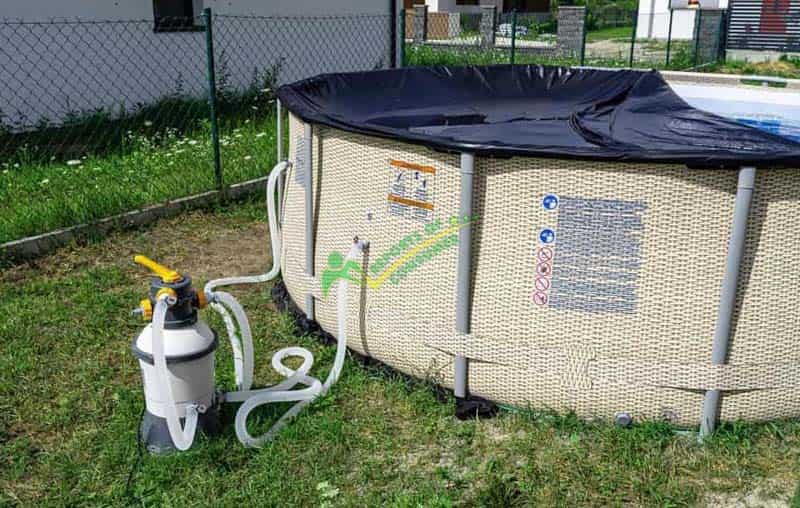
Closing your pool means to not use it for a small time period (maximum two weeks) and to turn Off the pool equipment and cover the surface with the pool cover to use it later on. Most of the homeowners close their pool (if they don’t use it daily in summer) in order to save electricity.
On the other hand, Winterizing your pool is done only when summer season ends and you want to keep it safe and sound for next summer season.
When winterizing, you remove the water present in the vessels and in the lines as well (which you don’t do when closing the pool). Also, removing the whole pool equipment, cleaning it and then storing it is basically winterizing your pool.
Material and Chemicals needed for Pool Winterizing
If we talk about the accessories needed when winterizing the above ground pool first, then you must have these;
- Winterizing kit.
- Winter Algaecide.
- Pool sock (chlorine).
- Pool pH accelerators and pH reducers (Sodium bicarbonate and sodium bisulfate).
- Winter skimmer plugs and skimmer covers.
- Ice equalizer (necessary).
- Cover clips, cables, cover winch and cover rope.
- Winter pool cover.
- Water bags (if your pool has decks; not found in above ground pools though).
- Expansion and return line plugs.
Steps to Winterize your Above Ground Pool
Before we jump directly into the steps, it is best to take into consideration that winterizing the pool isn’t a one-step procedure.
It takes 2 to 3 days to properly winterize the pool so when you want to use it again in the next season, the pool would function the same as the new above ground pool would.
1) Clean the pool (skimming, brushing and vacuum)
Now that you know you are going to winterize your pool, you need to clean your Pool properly one last time before closing it for the whole winter season.
As most of the good quality above ground pools are from Intex, Coleman and Bestway, this guide will help you to winterize and close them as well.
TIP: Don’t forget to turn Off the electricity connected to the pool.
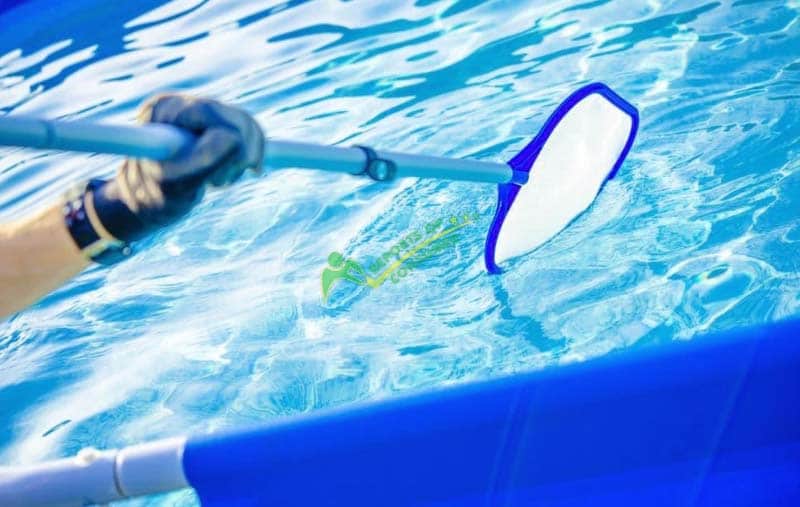
Remove the physical debris (leaves etc.) with the help of a skimmer, brush the pool walls thoroughly and deeply to clean them as well and then vacuum the pool. You can use any pool cleaner as well as per your convenience.
Just make sure there are no specs of dirt and debris left behind in your above ground pool and you pool is not leaking from anywhere. And if it has any leak already, then make sure to fix that leak of your above ground pool before you winterize it.
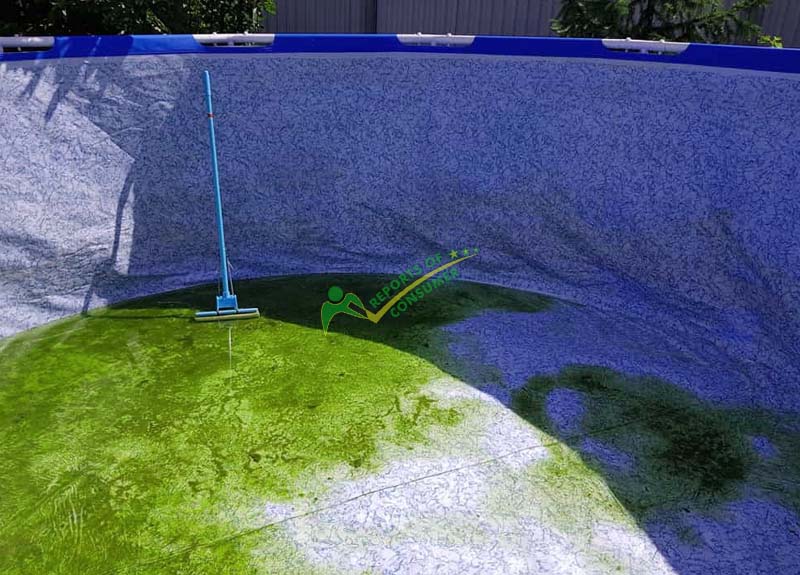
2) Test and Balance the Pool water (Alkalinity and pH level)
After cleaning the pool thoroughly and making sure each and every corner of your pool is cleaned, now check the water chemistry of your pool. The most important factors which have a great impact on the pool water’s quality are pH and alkalinity level.
You can check the levels with the pH kit or any digital pH meter, if the pH level is highly acidic then use pH accelerator (baking soda) according to this guide and if the pH level is very high (basic) then use pH reducer (sodium bisulfate) according to this guide.
Then again check the pH and alkalinity levels and if they are not balanced, repeat the process. Here are the recommended and safety limits of chemicals in the water:
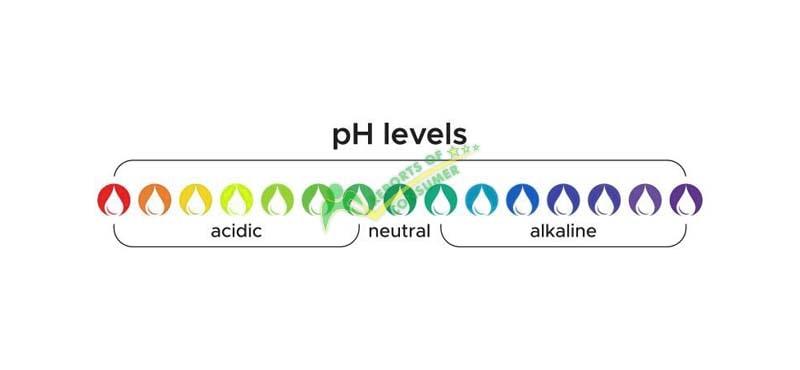
- pH = 7.2 to 7.8
- Alkalinity level = 80ppm to 120ppm
- Calcium hardness = 180ppm to 220 ppm (if the calculated level is not under this range, then the best solution is to drain the water and refill the water again).
- Phosphate levels = 100ppm to 125ppm (there are multiple phosphate removal chemicals available in the market to lower the levels).
4) Shock the Pool
After you have balanced the water chemistry of the pool, the next safety measure you should take is to shock your pool water so that the contaminants present in it can get killed and to kill the bacterial and algal growths.
The best chemical to shock the pool is chlorine. For regular use, add 1 gallon of chlorine (in liquid form) in 10,000 gallons of water and if your pool water seems a bit greenish, then add 2 gallons for 10,000 gallons of water (you can add according to your pool water capacity).
It would be best to keep the chlorine in the pool for 6 hours to function efficiently.
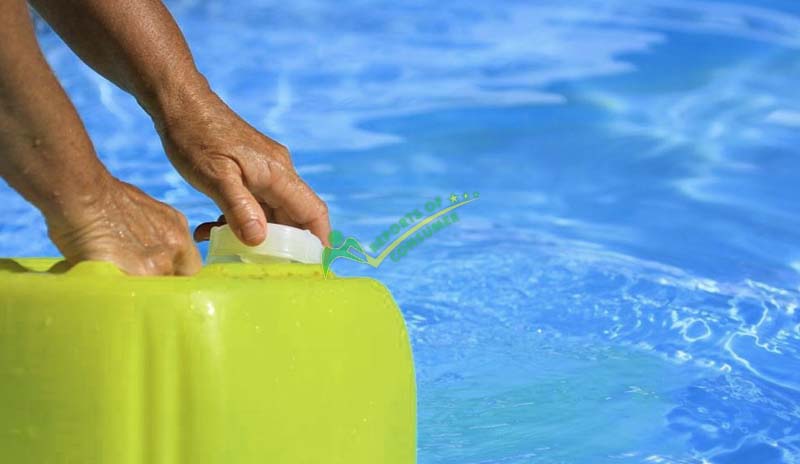
PRO TIP: It would be best to start adding the chemicals in the pool two or three days before winterizing the pool.
5) Remove the Pool equipment
Now after that, remove the ladder and floating toys from the pool and store them in your store.
For now, leave the pool pump, skimmer and other equipment which needs to be cleaned.
Recommended: Easy Way to Install an Above Ground Pool
6) Add Winter Algaecide and Winterizing Chemicals
Now we are closer to closing the pool for the season, and for that we need to winterize the pool water and we don’t need to drain the water for it as it is a great hassle to drain the water.
And in order to store the water for the whole season to keep it safe from getting contaminated, we need to add some Winterizing chemicals.
The winterizing kits come with all the needed chemicals and they are available in multiple packages (as per the size of your pools) with proper instructions of how to use them and how much quantity to be added.
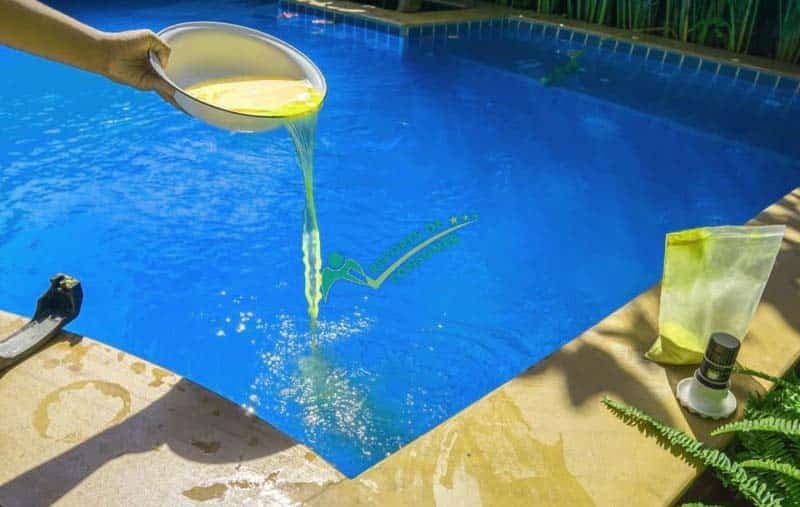
The winterizing kits come with; algaecides, scale-preventers, pool shocks and slow-release of oxidizing components in the pool. In short, all-in-one dose.
However, it depends upon you whether you want to add every chemical one by one or just add one Winterizing pill to get saved from the hustle.
OUR RECOMMENDATION: We would recommend you to opt for a winterizing kit.
7) Lower the water level and Winterize the skimmer
Now that you have balanced the whole chemistry of pool water and have added the winterizing chemicals to save it from the next season. Also, keep in mind, winterizing the pool water keeps it clean and sanitized for the next season.
However, lower the water level of the pool below the skimmer to protect it. You don’t need to drain the whole water of the pool. Just drain it below the skimmer (only if you don’t use the cover plate).
Now place the Winterize skimmer cover on the skimmer. The skimmer covers prevent the skimmers from getting damaged when the ice expands in winters.
In fact, these covers compress when ice expands on them to prevent the skimmer.
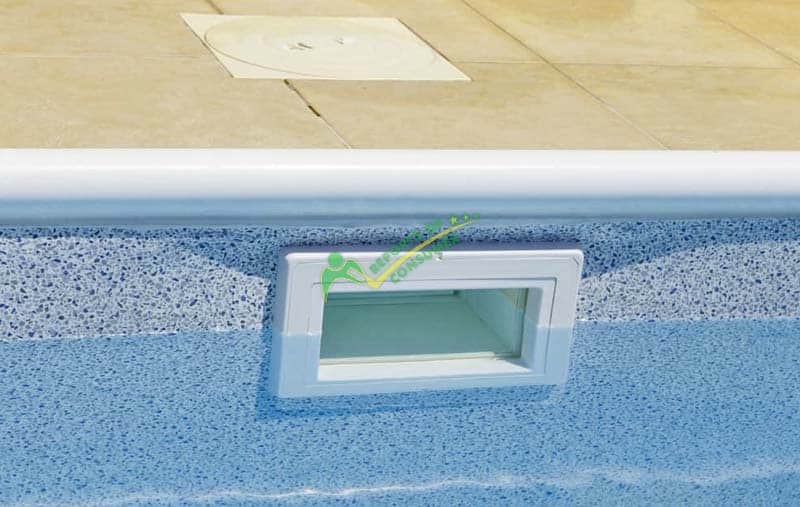
How far down do you drain your above ground pool for winter?
You only drain the pool lower to the skimmer if you don’t use the cover plate. Otherwise, there is no need for it.
Most of the above ground pools (inflatable ones only) don’t come with skimmers and to store them, one needs to drain the pool, deflate them and store them.
8) Disconnect the Water lines and Vessels
Just like other plumbing lines of your house, the pool vessels and lines get frozen as well when the temperature drops which can further break the pipes and water lines.
So, in order to prevent that, you need to drain the water from the water lines and sun dry them.
9) Winterizing Pool pump and filters
After removing all the pipes and draining water lines and plugs of the pool, our next target is to winterize the water pump and the filters.
First of all, talking about the pool pumps, simply remove all the drain pipes and hoses attached to it and drain the water from the pipes and let them dry (in sunlight).

If your pump has a chlorinator as well then remove it and its pipes. Store the pump, hoses and chlorinators (if any) inside the house after drying them completely to enhance their shelf life.
Winterizing Sand filters
Among all the filters, winterizing the sand filter is a bit tricky. Set the filter valve to the “winterize” and remove the bottom cap to let the filter drain completely. Don’t reattach the cap after that.
Sand filters mostly come with a “winterizing” valve which allows the filter to drain completely.

After draining it, remove the plugs and hoses, let them dry and then store them indoors.
Cartridge and D.E (Diatomaceous earth) filters
Unlike sand filters, all other filters are winterized with the same process;
- Drain them.
- Rinse the filters.
- Dry them.
- And then store them.
For salt water pools
If your pool has a salt water system, then either change the setting of the chlorinator with “winterize” or remove the whole salt system and store it.
10) Add Pool Air Pillow and Cover the Pool
Last but not the least, before covering the pool with the winterizing pool cover, the best tip is to add the pool air pillow (ice equalizer) in the pool water.
This ice equalizer helps to break the ice formed up under the pool cover when temperature drops. And, ultimately prevent the pool water from expanding.
Ultimately, the ice equalizers prevent the skimmers and pool liners from getting damaged. After that, put the pool cover and you are done.
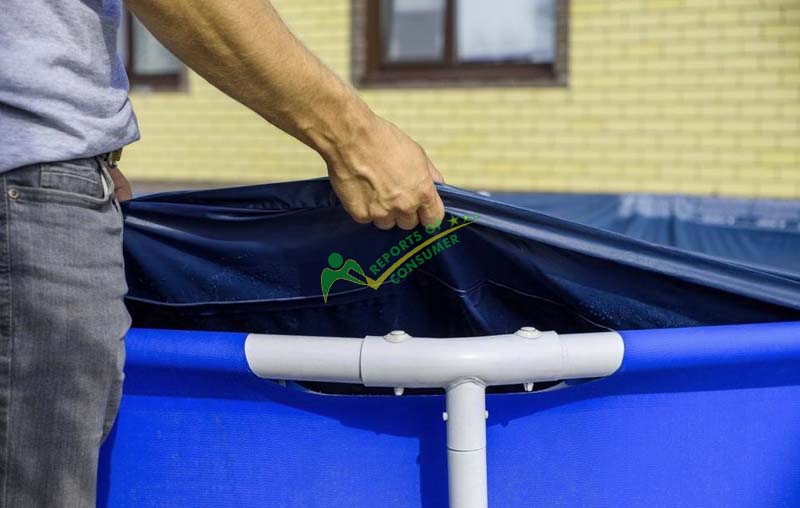
Steps to Close an Above Ground Pool
People often think closing or winterizing the above ground pool is the same process but it is not. When you are closing the pool you undergo these steps;
- Clean the pool.
- Remove the pool equipment.
- Shut down the electricity to save money.
- And cover the pool.
Closing the pool doesn’t save it from freezing like winterizing does. On the other hand, winterizing a pool is done to save it from freezing.
If you just close your above ground pool in winters, then your pool and the pool equipment will get damaged.
What Happens if you Don’t Winterize your Above Ground Pool?
Well, this one could be a great debate. A lot of newbies who start using the above ground pool don’t have any idea why to winterize the pool or why it is done.
If you don’t winterize your pool, the pool and the pool gets damaged and this damage can cause you thousands of bucks to repair.
If you live in an area where heavy snow falls in winters then there are high chances your pool will get torn due to expansion of ice when accumulated on the surface.
When to Winterize the Pool?
If the pool water temperature remains below 65 Fahrenheit (18 degree Celsius) then you need to winterize your pool. The best time to winterize the pool is in October.
PRO TIP: Winterizing the pool too early (in August or mid September) won’t help you as the chemicals added in it would lose their potency before time.
Now that you know the importance of winterizing the pools, what materials do you need or is there any chemical needed? Let’s have a look.
IMPORTANT NOTE: If you live in an area where temperature remains temperate whole year, then there is no need to winterize your pool.
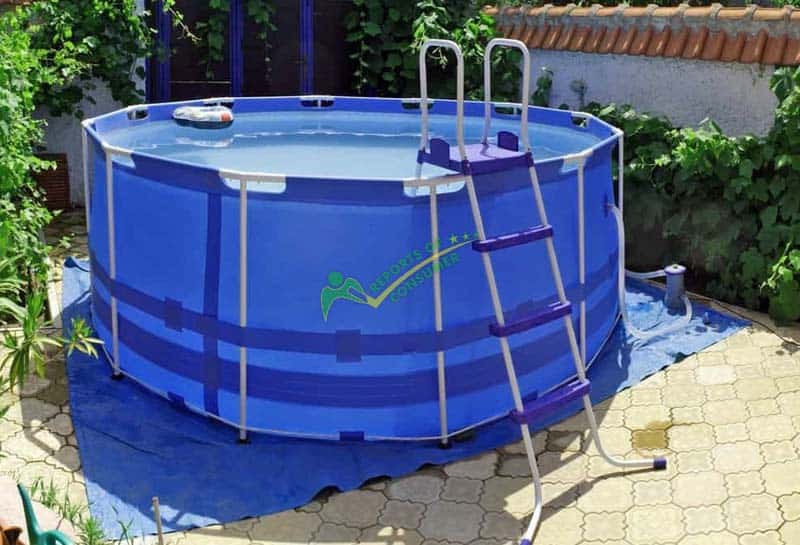
FAQs
How to winterize the pool without draining the water?
Winterizing of the pool is basically done without draining the water. You just need to lower the water level to protect the skimmer.
Draining isn’t done for it as it would be a great hustle to drain the whole water; the pool will get de-shaped.
What are winterizing pool kits?
The winterizing pool kits include the chemicals which prevent the pool from getting frozen in winters and don’t let the ice expand, resultantly preventing the pool from getting damaged.
Can you leave water in an above ground pool in winter?
Yes! Draining the whole water is not recommended when winterizing the pool as it will damage your pool in winters. Also, removing the water completely de-shapes the pools.
Wrapping Up
That would be all from our side for today. We hope you know the importance of winterizing the pools and how it differs from closing. Also, draining the pool completely for winterizing is not recommended at all.
Addition of ice equalizer in the pool water is like the cherry on the top and prevents the pool from getting damaged when it starts to freeze up.
In addition, keep in mind, winterizing the pool isn’t a one day process, it requires 3 to 4 days to completely winterize the pool (due to addition of chemicals and water testing).
However, if you are facing any difficulty while performing these steps, then you can ask us.

